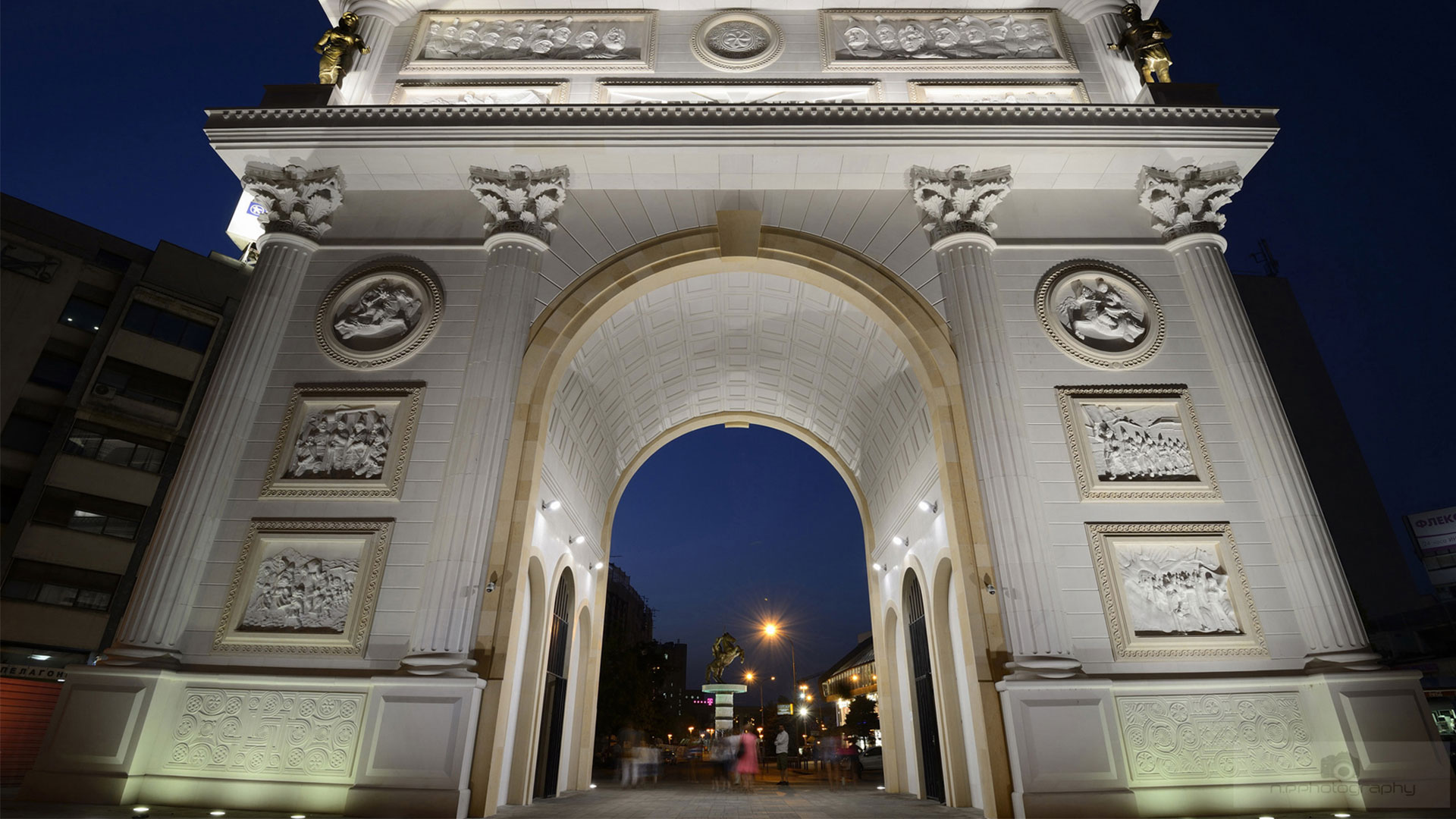Tourist attractions and cultural features of the Skopje region
The Skopje region is competitive in SEE with recognizable potential for investments and development in function of raising the standard and quality of life of citizens and utilizing and protecting the natural and cultural heritage evenly in the region. It is rich in natural and cultural-historical facilities: the archaeological site Skupi, the fortress Kale, the aqueduct, the Old Town Bazaar, numerous churches and monasteries, etc. The region successfully develops urban, spa, transit and alternative tourism. Skopje region is located in the northern part of Macedonia and borders with the: Vardar, Polog, Northeast, East and Southwest region.
Location of the Skopje region
According to the location, the Skopje region covers the basin of the Skopje valley and covers a total area of 1812 km2 or 7% of the territory of the Republic of Macedonia. The Skopje valley is limited by mountain ranges, Skopska Crna Gora to the north, Gradishtanska Mountain to the east, the massif Mokra Mountain in the south and the branches of Karadzica, Suva Gora and Zeden to the west. The region is directly in touch with the beautiful cliff valleys of the Vardar River, such as the Derven and the Taor Ravine, the Sishevska Ravine of the Treska River, the Kachanica Ravine of the Lepenac River and the Badar Ravine on the Pchinja River.
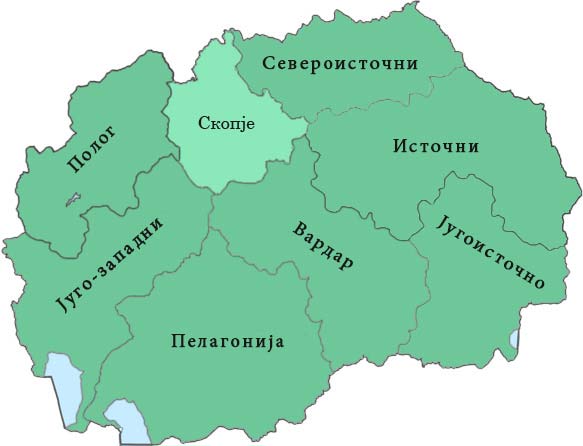
The Skopje region comprises 17 municipalities, 10 of which are part of the City of Skopje, as a separate unit of the local self-government. They are: City of Skopje, Aerodrom, Butel, Gazi Baba, Gjorce Petrov, Karpos, Kisela Voda, Saraj, Centar, Suto Orizari, Arachinovo, Zelenikovo, Ilinden, Petrovec, Sopiste, Studenichani, Cucer Sandevo. For more information, please visit Centre for Development of the Skopje Planning Region.
Traffic routes in the Skopje region
There are several traffic routes in the Skopje region: one from Belgrade to Thessaloniki (road E-75), the second from the Adriatic Sea to Thessaloniki, the third from Kriva Palanka and Kumanovo and the fourth from Ohrid and Debar to Skopje. The City of Skopje is the central railway node. In terms of air transport, one of the two national airports - "Skopje International Airport" is located in the Skopje region, which is of great importance for the functioning of the region as a commercial and administrative centre of the country. The Skopje region also has a sports A class airport, located in the vicinity of Skopje. One road and one railway crossing with Serbia, as well as a border crossing located at the airport "International Airport Skopje" are found in this region.
Climate in the Skopje region
The Skopje region is characterized by average annual temperature of 12⁰С and average annual quantity of rain of 500 mm. The region is characterized by a continental climate with small penetrations of Mediterranean influences, and in the higher regions a mountainous climate prevails.
Natural resources, flora and fauna in the Skopje region
The Skopje region is confined to the mountain massifs Skopska Crna Gora to the north, the Gradishtanska Mountain in the east, the Mokra Gora massif to the south and the branches of Karadzica, Suva Gora and Zeden to the west. Mountains that are in the vicinity of the city of Skopje and are visited by thousands of visitors are: Skopska Crna Gora (1,653 m), Zeden (1,259 m) Vodno (1.066 m), Kitka (1.589 m), Karadzica (2.217 m) etc.
Vodno is the closest and most visited medium-sized mountain with favourable geographical position to Skopje. The highest peak is Krstovar, 1.066 m high, where the mountain lodge and the Millennium Cross are to be found. There is a cable car to the top of Vodno. The surrounding area of the Skopje region is surrounded by several ravines, as follows: that of the river Vardar - Zedenska or Dervenska and Taorska; of the river Treska - Shishevska; of the river Lepenec - Kacanica and the of river Pchinja - Badarska ravine.
Matka Canyon
There is also one canyon in the Skopje region, the Matka lake & canyon on the river Treska. On the surrounding mountains and at the edge of the valley there are several caves, of which the most famous are: Dona Duka, Vrelo, Krshtalna and other. The Vrelo Cave consists of two caves (overwater and underwater). The underwater cave Vrelo is currently the deepest underwater cave in Europe, with a depth of 212 meters discovered so far. The overwater cave Vrelo, or the "Nad Vrelo" cave, has a length of 150 meters. Although with modest dimensions, it is one of the richest with cave decorations, stalactites, stalagmites, columns, etc.
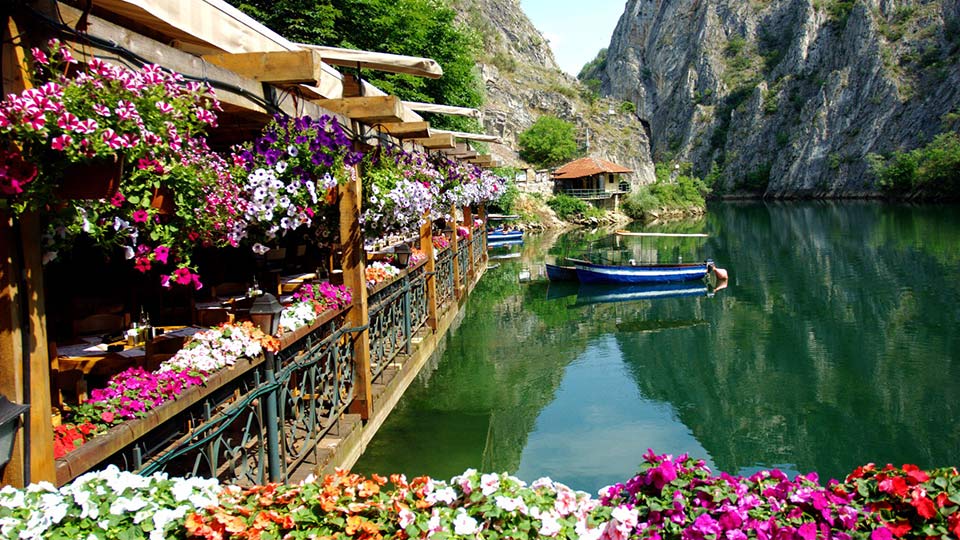
Hydrological characteristics of the Skopje region
The Skopje region is also known for its rivers running and flowing into the main Macedonian river Vardar. These are the rivers Treska, Lepenec, Patiska Reka, Kadina Reka and other smaller ones. The river Vardar is the main river and it divides the valley into two parts: east and west. Vardar also flows through the capital of the Republic of Macedonia, Skopje, and it is a length of over 20 km. In the vicinity of the city of Skopje the artificial lakes Matka and Kozjak can be found. Another important hydrographic object is the Rasce spring, from which the city of Skopje with the surrounding settlements is supplied with drinking water. Besides its hydropower potential, Treska and Kadina River with its ambient beauties offer excellent conditions for recreation and development of tourism and hospitality content.
In the Skopje region there is also a bath, that is Katlanovo Bath. In summary, the natural heritage in the region consists of: Vodno, Katlanovsko Blato, Matka Canyon, Jasen Nature Reserve and other smaller facilities. The thermal and thermal-mineral waters in Katlanovo are of particular mineral importance, which provide an opportunity for the development of spa tourism in this area. The diverse geological composition, relief dissection, the presence of water and climatic influences enabled a rich floral world with diverse dandoflora and grassland vegetation. The fauna is represented by a diverse big and small game: bear, wolf, wild goat, wild boar, rabbit, partridge and various other species that are of interest to tourists.
Natural and cultural-historical heritage in the Skopje region
The City of Skopje is the capital of the Republic of Macedonia, a city with a history of several millennia from the Neolithic era, through the antique period and the Middle Ages to the present, over 7,000 years of being a continuous settlement. Skopje and the surroundings of Skopje region have well-known cultural-historical monuments, archaeological sites and memorials..
The region has the following museums, memorials and national cultural institutions: Archaeological Museum, Museum of the Macedonian Struggle, Natural Science Museum and Zoo, Ethnological Museum, Archaeological Museum, Macedonian Ethno Village, Memorial House of Mother Teresa, Museum of the Holocaust, the Museum of the City of Skopje, the Museum of Contemporary Art, the Macedonian National Theater, the Macedonian Opera and Ballet, the University Library, the Universal Hall, several universities and a dozen other national institutions..
Tumba Madzari
Tumba Madzari is a prehistoric settlement in Madzari in the Skopje region, from 6,200 to 4,200 BC old - seven houses (dwellings) were explored with movable inventory - vessels, objects, house terracotta altar of the goddess Great Mother - protector of fertility and one sanctuary. Based on the excavations, it has been established that it is a multifaceted settlement with a cultural layer of three meters in which three horizons of living from the Middle Neolithic period are separated. Today, three houses have been reconstructed in this place, which are with a rectangular and square-shaped fundament, built of timber, clay mud, covered with straw and in which authentic fireplaces, ceramic vessels, various objects from the middle Neolith, human and animal dolls were placed.
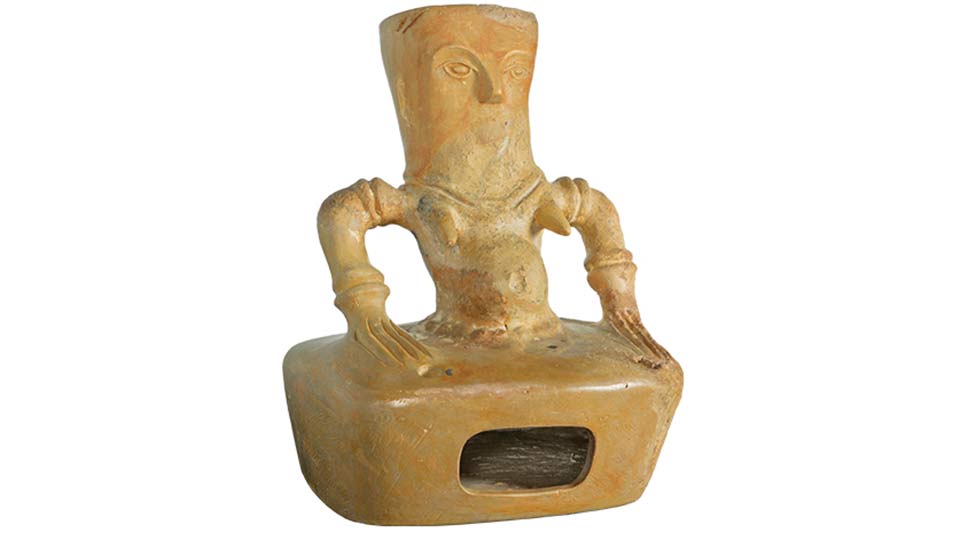
Skupi
Skupi is an archaeological site, a city of Roman and late antique period. The name denotes a dwelling, houses. It is located 5 km northwest of Skopje in the immediate vicinity of the village of Zlokukani, to the left of the mouth of the Lepenec river, at the foot of Zajcev Rid. This site has been known from the end of the XIX century. The systematic archaeological research began in 1966, which with smaller interruptions, is continuously carried out to date. So far, the walls, the theater, the civil basilica, the Christian basilica, the town's mansion (palace), the city bath, the street - cardo, parts of the eastern and the western necropolis have been fully or partially explored.
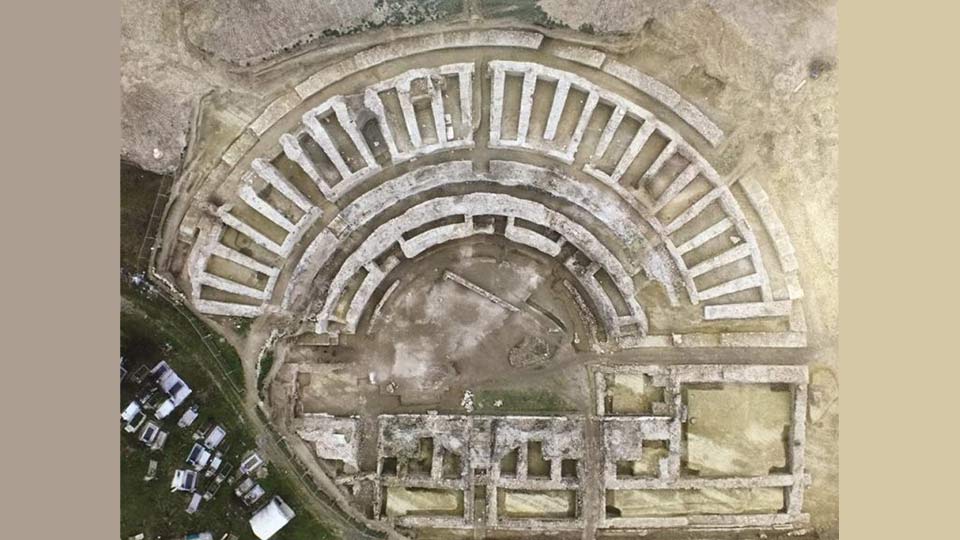
Kale and Stone Bridge
The latest archaeological data indicate that the Kale fortress was inhabited since the Neolithic period (before 3000 BC) and in the early Bronze Age. The remains of earthenware, huts and palisades confirm this statement. The fortress is also known for its wall, which dates back to 535 AD, from the time of Justinian I rule. Being situated in a very important strategic location, the fortress was besieged and attacked several times..
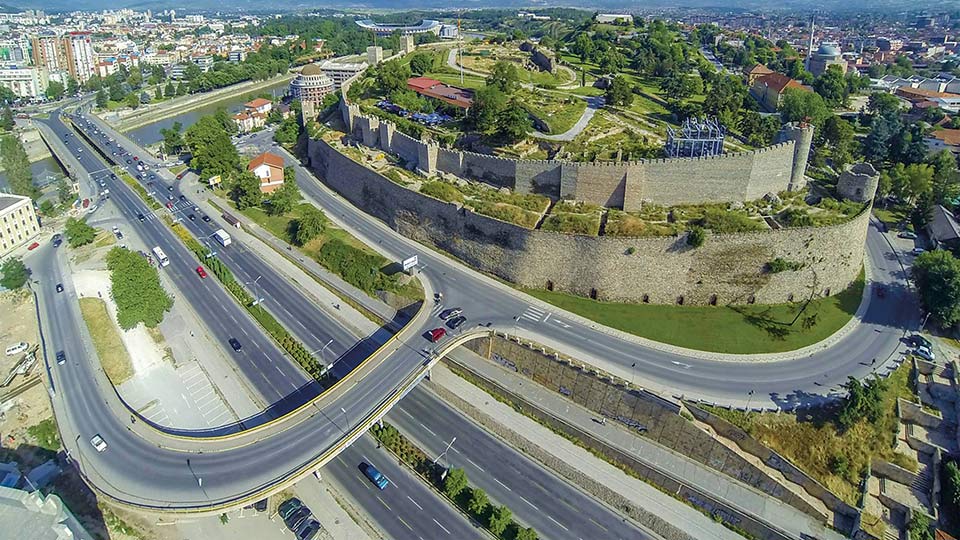
The Stone Bridge is a symbol of the city of Skopje. It is located in the very centre of the city, on the river Vardar, and is a connection between the old and the new part of the city. According to new research in 1990, it is assumed that the Stone Bridge was built in the 6th century, during the reign of Emperor Justinian I, and in the fifteenth century it received its today's appearance, during the reign of Sultan Mehmed II. The stone bridge was built of fine-made stone blocks, and its construction lies on massive columns connected by 13 semi-circular arches.
Archaeological site Gradiste, village of Taor
It is Taurusium, the birthplace of the Byzantine Emperor Justinian I (483-565). It is located on the site "Gradiste" above the village of Taor, in front of the entrance to the Taor Ravine, 20 km from Skopje. On this site, layers of three settlements of different historical periods - Eneolithic, Late Antique and Medieval period were registered. A castel with a triangular base on the walls, towers, one bastion, fortified terraces, plumbing remains, late antique necropolis, part of a marble monument, pillars from the early Christian basilica, various coins and so on, were discovered.
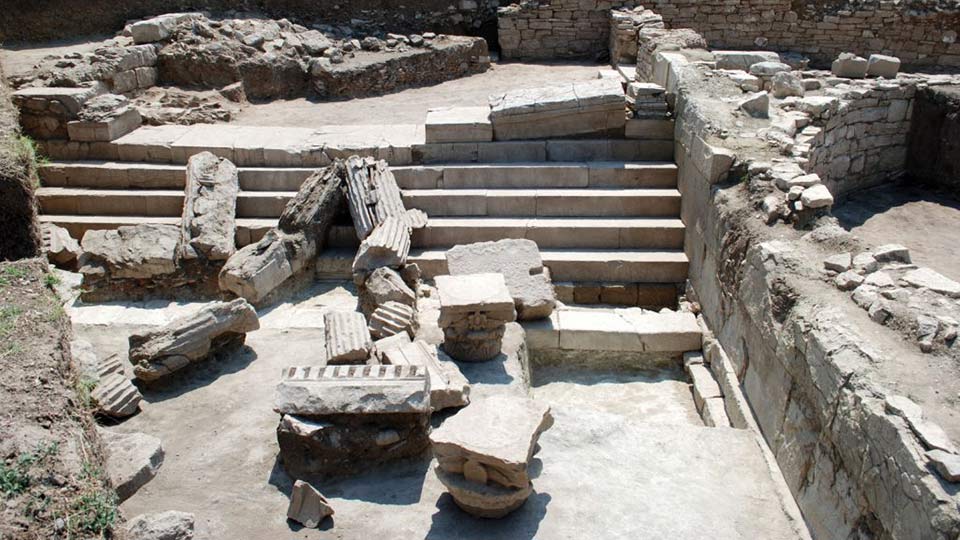
Aqueduct
The Roman aqueduct is located on the outskirts of the Skopje region, along the Skopje-Kachanik road. It was built of brick and stone. It supplied the city with water from the mountain Skopska Crna Gora. From the former 200 archs, 50 have been preserved today. It is assumed that it was built in VI century, in the time of Justinian I, and therefore this aqueduct is also called Justinian's aqueduct.
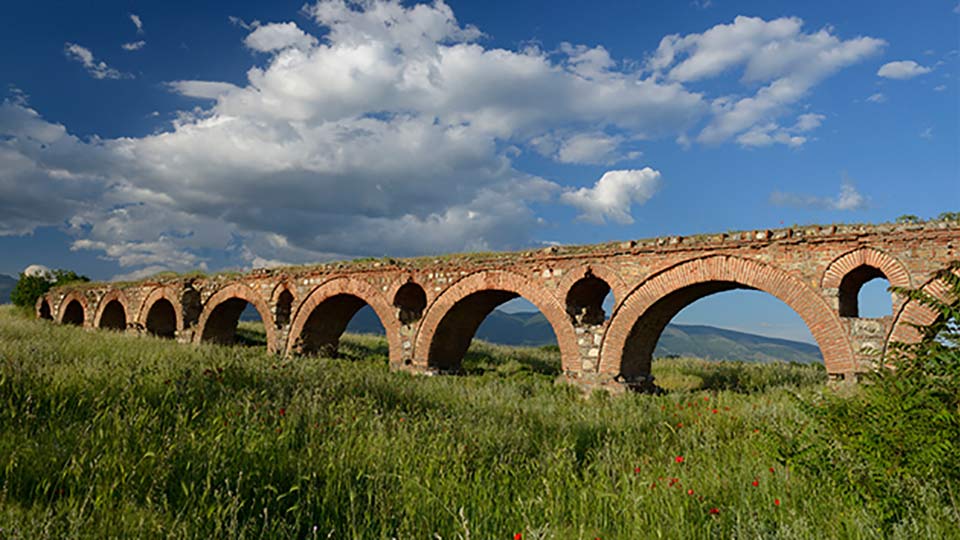
Churches and monasteries in the Skopje region
St. Pantelejmon Monastery, village of Gorno Nerezi. On the walls of this monastery - an artistic monument, fresco painting has been preserved, which according to its qualities rightfully counts among the top achievements of the Byzantine painting from the period of the XII century, the time of the rule of the famous Komnin dynasty. Accordingly, this monastery has an exceptionally rare fresco painting value (about nine centuries old) to Macedonia, Europe, and also to the world. The monastery was built in 1164 with the assets of the Byzantine prince Alexei, the son of Constantine Angel and Theodora, the youngest daughter of the Byzantine emperor Alexei I Komnen.
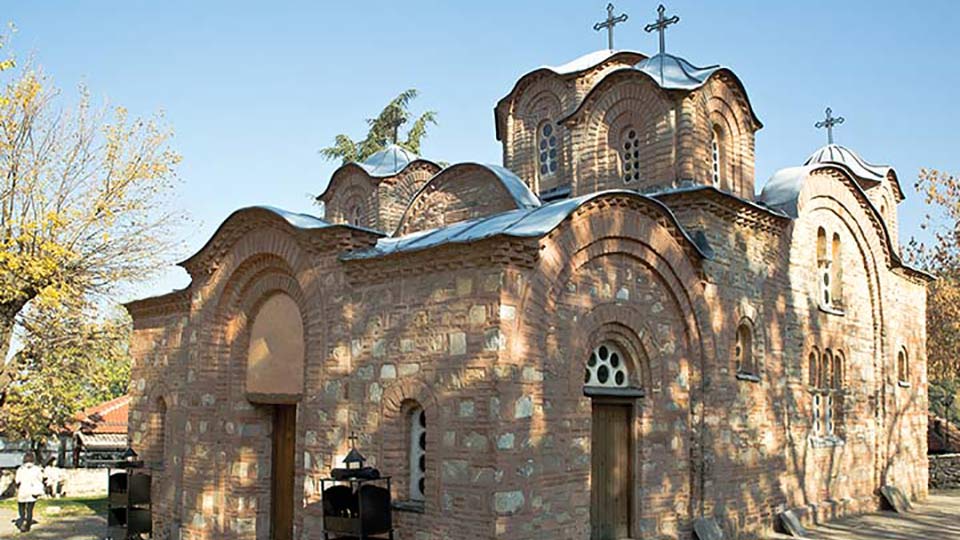
The particularity of the building is reflected in the style of the construction, built by unknown talented builders and unknown talented painters of the frescoes, which according to what was painted were the most significant ones of their time. The monastery was built on a monolithic rock, the building was made of stone and brick, in the form of an inscribed cross in a rectangular space and has five domes. Particular attention is drawn to the fresco-paintings of "Mourning of Christ", "Communion of the Apostles", "The Birth of St. Mother of God," "Entry to Jerusalem "," Taking down from the Cross" and so on. During the long history, the monastery survived a fire, earthquake, ruining and robberies, but remained a holly and bright witness of the rich church and cultural life. Today the monastery is accessible and open to visits and stays for many believers and tourists.
St. Nikita Monastery
On the slopes of Skopska Crna Gora, northwest of Skopje, between the villages of Gorenje, Banjani and Cucer, on a hill, the monastery St. Nikita was built. It was built on old foundations in 1307/8. Architecturally, the church was built in the form of an inscribed cross in a rectangular space. It was made of stone and bricks connected with mortar. The fresco painting in the church originates from the time it was built, with the exception of some parts of new fresco paintings.
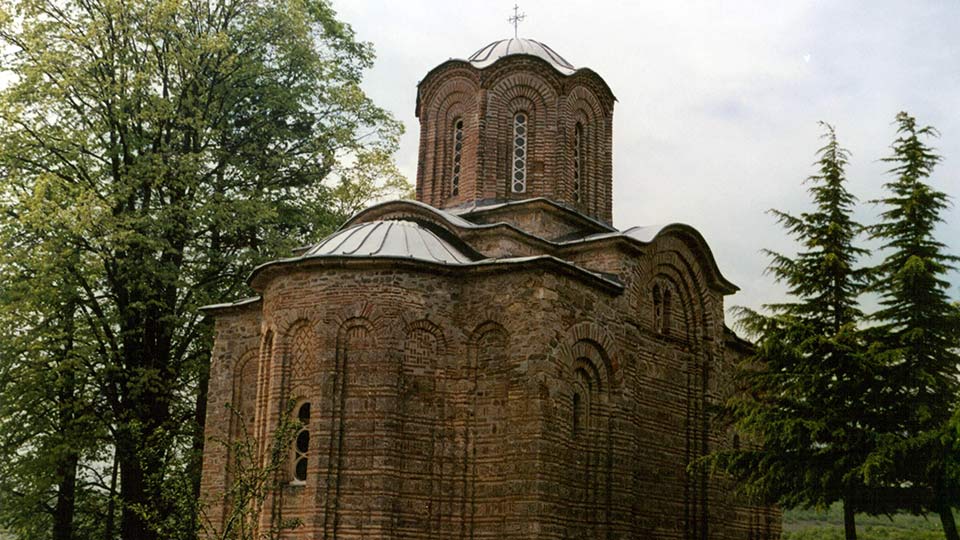
The church was painted by the painters Mihailo and Evtihij. The same painters are creators of frescoes in the churches St. Clement (Bogorodica Perivlepta) in Ohrid and in the church of St. Gorgi in the village of Staro Nagorichino. The frescoes of the church are divided into three zones. The first zone consists of saints in full size, who were painted en face. The frescoes of the second zone are dedicated to "the miracles of Christ." The third zone illustrates the frescoes depicted through the compositions of "Christ's torments", from which the most important is the fresco "the Secret Dinner/the Last Supper".
Church Introduction of the Holy Mother of God
On the slopes of Skopska Crna Gora, in the village of Kuceviste, there is a church dedicated to Introduction of the Holy Mother of God. In the population it is known under the name St. Spas. The church was built before 1348, and frescoed between 1355 and 1358, by the painter Gregorij. Architecturally, the church basically shows an inscribed cross in a rectangular space, above which a high dome of four pillars rises. On the outer side, the apse is five-sided, decorated with niches and fields, with decorative built-in bricks.
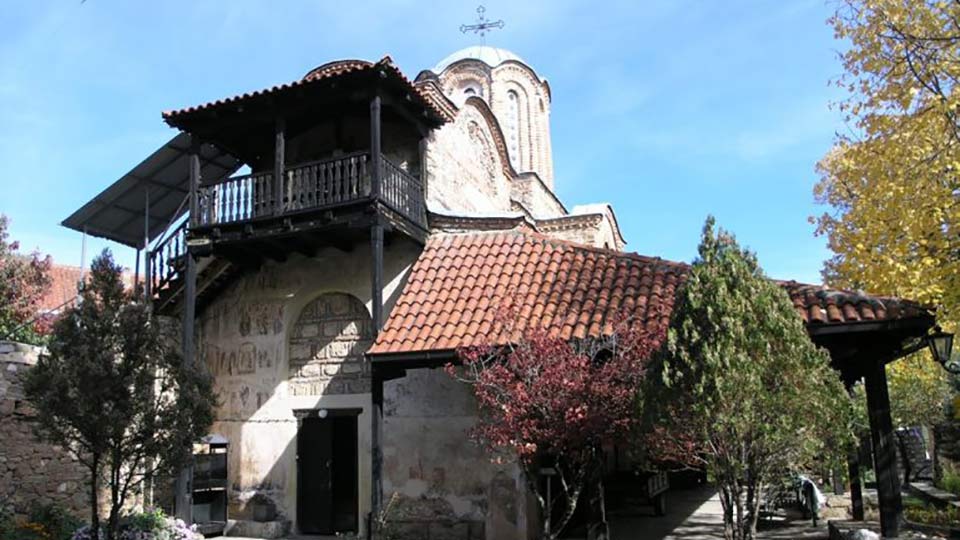
The talented painter made several compositions, of which the most important are: "Washing the Feet", "Mourning of Christ", "Mother of God with Christ" and so on. During the long history, the church has been renovated several times, so today there are several layers of frescoes, where a gallery of characters has been created, occurring at different times. Inside the church there is an iconostasis with many icons made in the XIX century. Among them a special place is dedicated to the icon (door) of Dicho Zograf from the village of Tresonce, created in 1845, and it is one of his earliest works.
In the immediate vicinity of the village of Kuceviste, in the valley of Kuceviska Reka there is a monastery church dedicated to St. Archangel Michael and Gavril. The church has the form of an inscribed cross with a dome. The year of the church's construction has not been established. It was established that the church was frescoed in 1591. Judging by the method of construction and the stylistic features of architecture, the church was probably built at the end of the 14th or early 15th century.
Marko’s Monastery St. Dimitrija
In the vicinity of the village of Susica, in the Skopje region, there are several churches and monasteries from the 14th century: Marko’s monastery, the church of the Holy Mogther of God and the Church of St. Archangel Gavril. Marko's monastery obtained its name since the founders were King Volkashin and his son - King Marko. The monastery church was built in 1345 and frescoed between 1366 and 1371/2. This monastery consists of several buildings arranged as a wreath around the church, the old and the new lodge, the old monastery dining room, bell tower, mill and other auxiliary facilities. The church is in the form of an inscribed cross, and it was built with stone bricks. An asphalt road leads to the monastery, and during the year it is visited by many believers and tourists.
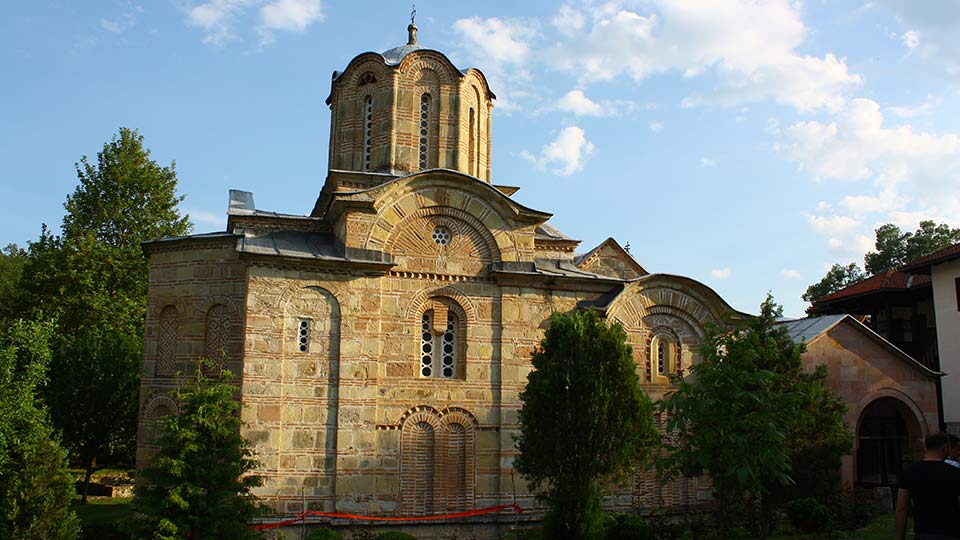
St. Andrej Monastery
In the canyon of the river Treska, to the shores of the artificial lake Matka, the monastery St. Andrej or St. Andrea is located. In the inscription in the church it is mentioned that it was built by Andrea, the second son of King Volkashin, in 1388/89. Inside the church there are several inscriptions, the monk Kalest Kiril has been mentioned, who together with the other "brothers" participated in the construction, was the abbot and founder of the church, and died after the fresco painting was finished.
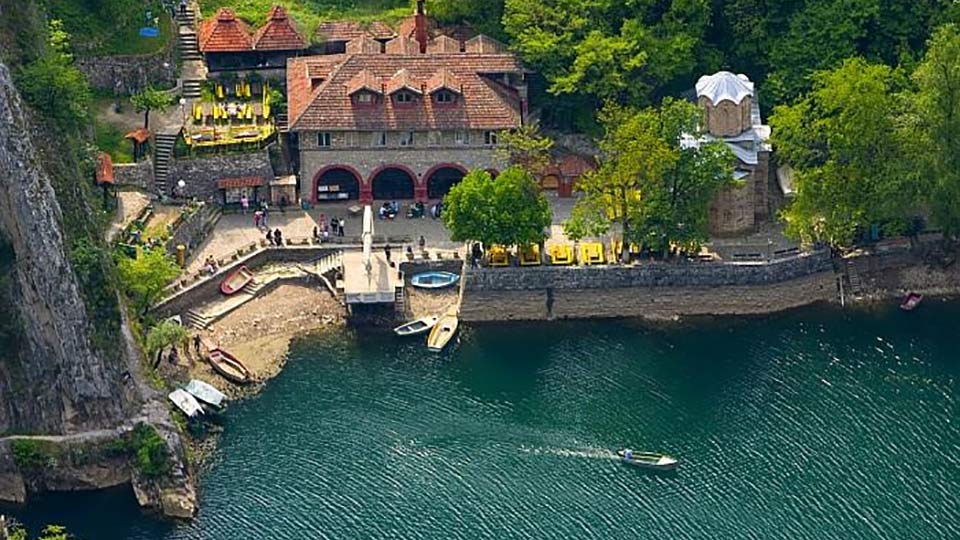
Also, in another inscription the painters are mentioned: Metropolitan Jovan, painter, and the monk Grigorij, who worked in the monastery St. Preobrazenie in the village of Zrze. The frescoes in the church are represented in three horizontal zones, and the frescoes of the holy warriors are particularly noticeable: St. Gjorgij, Dimitrija, Teodor Tiron and Teodor Stratilat, shown in the first zone in full size. In the second or middle zone, there are several scenes from the "Torments of Christ". In the third, upper zone scenes from the cycle of the Great Holidays: "The Birth of Christ," "The Meeting," "The Baptism of Christ" etc. are illustrated. Today, due to the accessibility and attractiveness of the area, this monastery and the immediate surroundings represent an interesting tourist zone, which is quite visited by believers and tourists from Macedonia and abroad.
Church St. Spas/Saviour
There are many churches in Skopje, but the oldest one is the church of St. Spas. According to historical sources, a number of churches were built in Skopje in the period from the X to the XIV century, but none of them survived to this day. In the church we find remains of frescoes on the southern wall dating back to the seventeenth century. The rebuilding of the church was performed after the city's burning in 1689, and with that of the previous old church. The church got its final appearance at the beginning of the 19th century. The church is half buried, so that it can not dominate, but be in the shadow of the surrounding mosque.
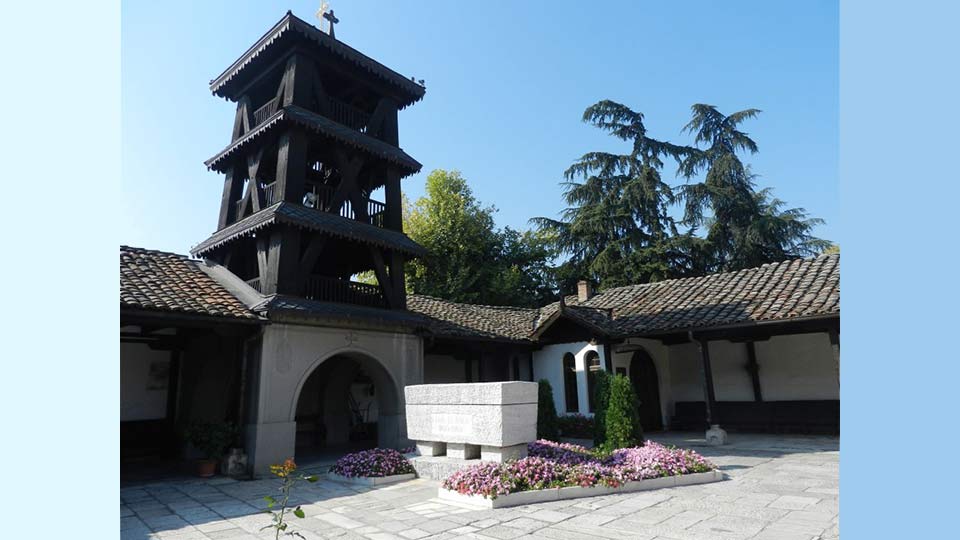
It is famous for its impressive iconostasis (10 metres wide and 6 metres high), a work by the workers of Makarija Frckovski from Galichnik, which worked on it from 1819 to 1824. The iconostasis was made of walnut wood and shows scenes from the Old and the New Testament. In the courtyard of the monastery, next to the church, is the grave of the revolutionary Goce Delchev. During the year, the church is visited by many tourists and believers. There are many churches and monasteries in Skopje and its surroundings. Important churches in the city of Skopje are: St. Dimitrija, Holy Mother of God, St. Gorgija, H. Petka, the cathedral St. Kliment Ohridski/Clement of Ohrid and so on.
The Cathedral St. Kliment Ohridski/Clement of Ohrid
Skopje is one of the most important buildings of the recent history of Skopje. The cathedral was sanctified in 1990. The form of the temple is an architectural construction of a blend of the old with the new styles of Macedonian church architecture. It is an imposing building in a combination of four domes and towers ending in a large ostagonal dome, with a large gold-plated cross at the top. The interior of the church is fresco-painted and has a large iconostasis of four parts, made by Macedonian artists, painters and carvers. In the courtyard of the church there is a fountain which is a gift from the Islamic religious community. Additionally, in the yard of the church there is a monument of its patron, St. Kliment Ohridski, as well as a high bell tower.
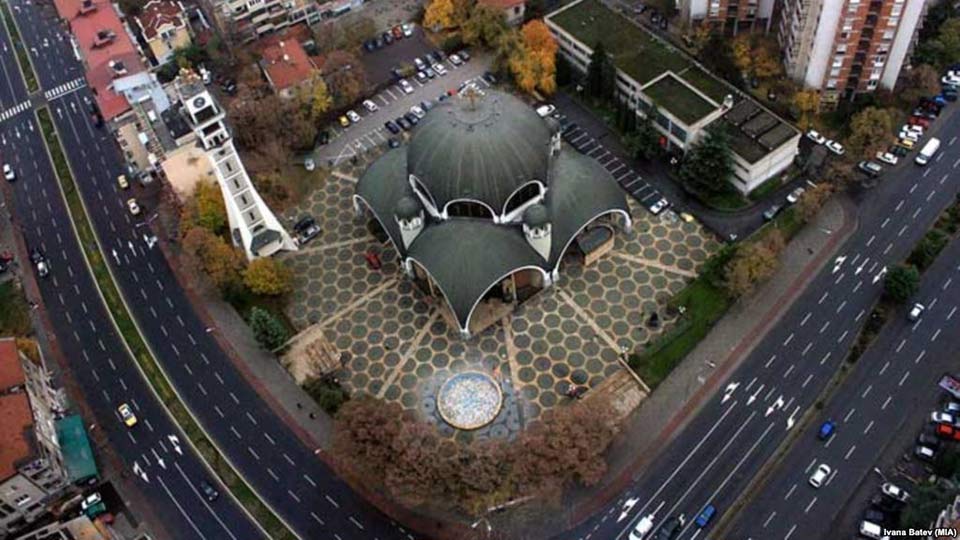
Ottoman monuments in the Skopje region
Sultan Murat – Hynkar Mosque
Sultan Murat II in 1436 erected this mosque as its heritage. However, throughout history, the mosque has suffered repeatedly, but has been renewed every time. The second name of the mosque Hyunkar (Tsar’s, Sultan’s) or Saat Mosque/Clock Mosque is due to the clock tower in its yard, built between 1566 and 1572, as the first clock tower in the Ottoman Empire. The clock tower is 40 metres high and has three parts. In the courtyard of the mosque there are two turbes, that of the Beyhan Sultan and the family tomb of Ali Pasha from Dagestan.
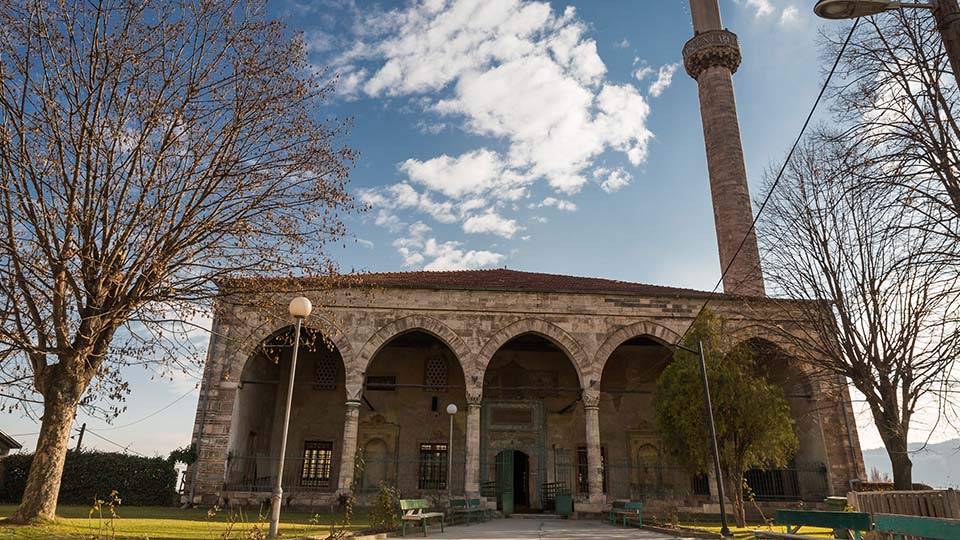
Ishak Bey’s (Painted) Mosque or Gazi Isa-Bey’s Mosqu
Built by Isak Bey in 1438, who besides the mosque as a heritage, also built a turbe, medrasa, lodgings and buildings belonging to the profane architecture. Throughout history it has been repeatedly repaired, damaged, and recovered. It obtained the name Aladza, which means colourful, because of the colourful tiles, which are now preserved only on the turbe behind the mosque. Isa Bey’s Mosque, Skopje, this mosque is located in the immediate vicinity of Bit Pazar in Skopje. It was erected in 1475 by Isa-bey, the son of Ishak-Bey, the founder of the Aladza Mosque, as a legacy. There are two domes, and on the entrance to the mosque there is a porch with pillars with five smaller domes.
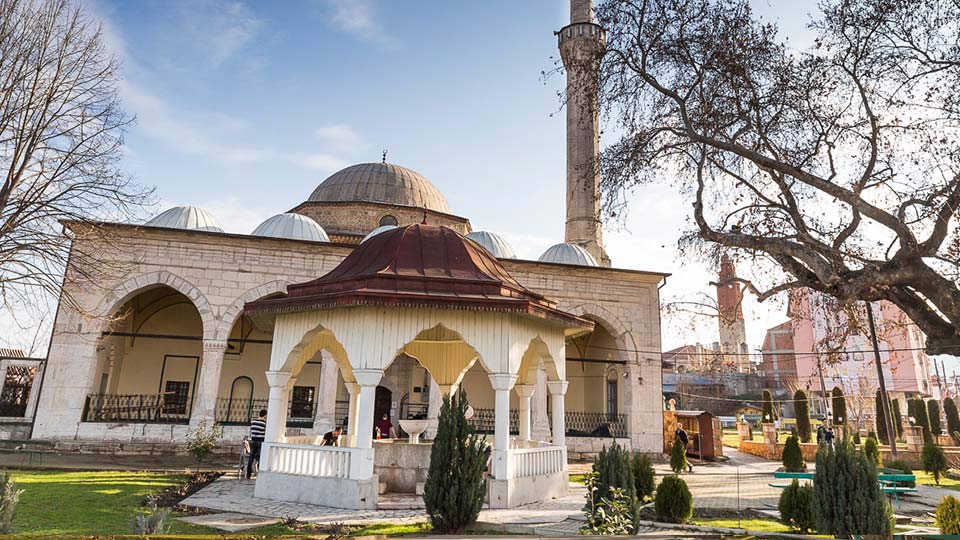
Mustafa Pasha Mosque
Mustafa Pasha mosque was erected in 1492 by the commander of Skopje, Mustafa Pasha. Mustafa Pasha died in 1519 and was buried in the turbe, which is located beside the northeast wall of the mosque. Today in the courtyard of the mosque is Mustafa Pasha's turbe, the sarcophagus of his daughter Umi, the fountain, several tombstones, as well as the remains of the former imaret and the medresa. The mosque has an imposing dome and a narrowly elevated minaret. In front of the mosque a porch is placed with four marble pillars with three smaller domes. The mosque is built with alternating rows of clay stone and two rows of bricks.
Yahya-Pasha Mosque, Skopje
The mosque was erected in 1504 by Yahya-Pasha in Skopje as his legacy. During its existence, it has been repaired and rebuilt many times. The minaret of the mosque is 50 meters high and is considered the highest among the minarets of other mosques in Skopje. At the top of the minaret there are a crescent and a star, made of gold. Tombstones and a turbe are preserved in the courtyard of the mosque.
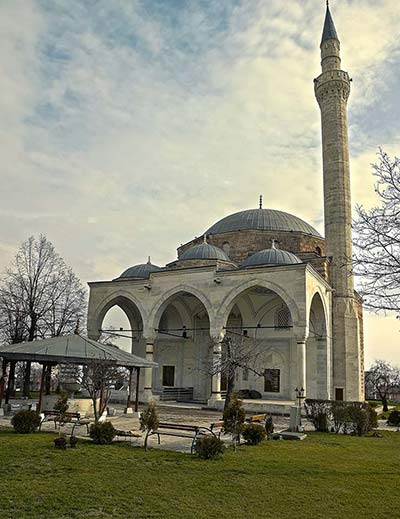
Features of the Old Skopje Bazaar
Chifte Amam. The amam is the work of Isa-bey, as a legacy, built in 1531. The amam is divided into two parts, with separate entrances for men and women baths, which is why it was given the name Chifte Amam (double amam).
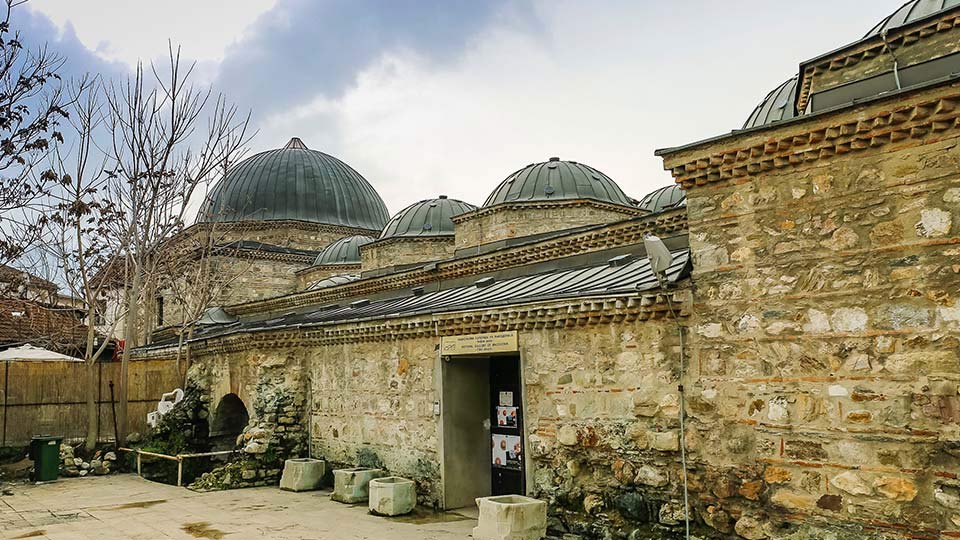
Daut Pasha amam. In the immediate vicinity of the Stone Bridge, in the old part of Skopje, is one of the most monumental monuments of the Islamic profane architecture - the Daut Pasha amam. In the period from 1489 to 1497, Daut Pasha was a great Vizier of Rumelia and raised the amam with his own funds. The amam for some time was left to a gradual collapse, but after the reconstruction, nowadays there is an Art Gallery in it.
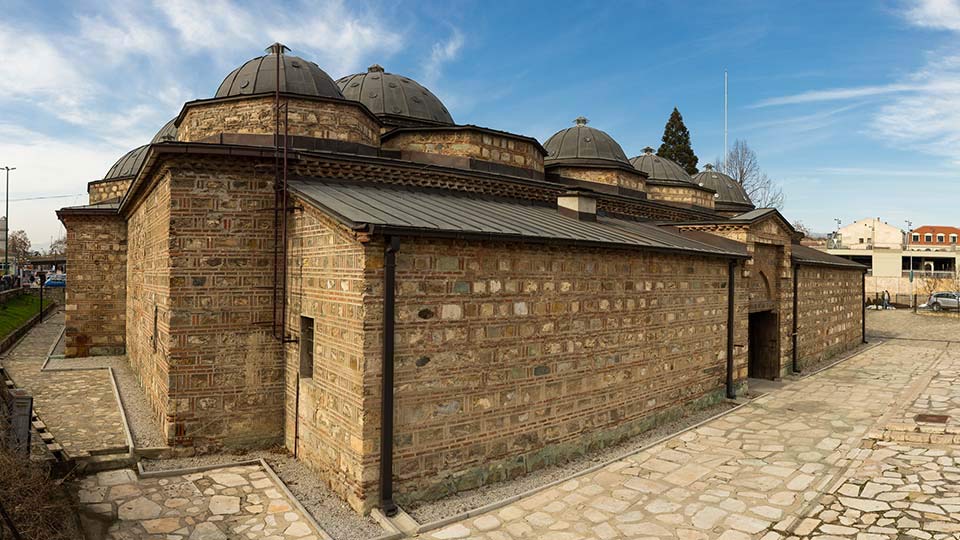
Kurshumli-an. There is no exact date and data for the building of the an. It is situated in the Old Skopje Bazaar. The an obtained its name by the roof of the numerous domes coated with lead (bullet). Kurshumli-an changed its function in the course of its existence: it was first an, then it was converted into a prison, and then into an an again. Today, its premises are used as a lapidarium of the Archaeological Museum.
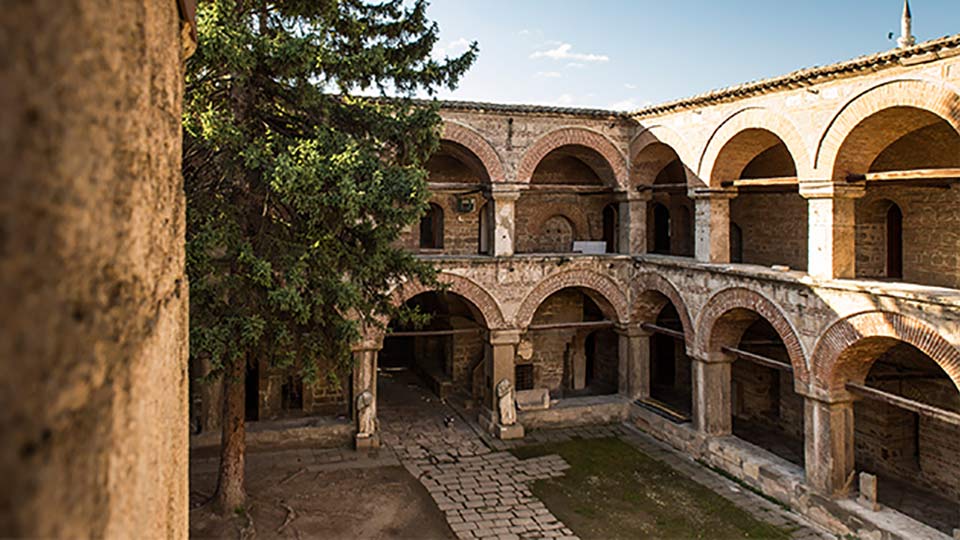
Additional tourist attractions in the Skopje region
The Millennium Cross in Skopje was built in 2002 in the honour of 2000 years since the emergence of Christianity. The foundation of the millennium cross is supported by 12 small pillars that symbolize the twelve apostles, and four large pillars (10 meters high) that symbolize the four gospels and which, together with the immediate surroundings, form a cross. Above them is a 67-meter high steel construction and a span of 46 meters of the sides. The cross is divided into 33 parts that symbolize the years of Jesus Christ. At night the cross is illuminated with 650 lamps. The Millennium Cross is visible in a 40 km radius.
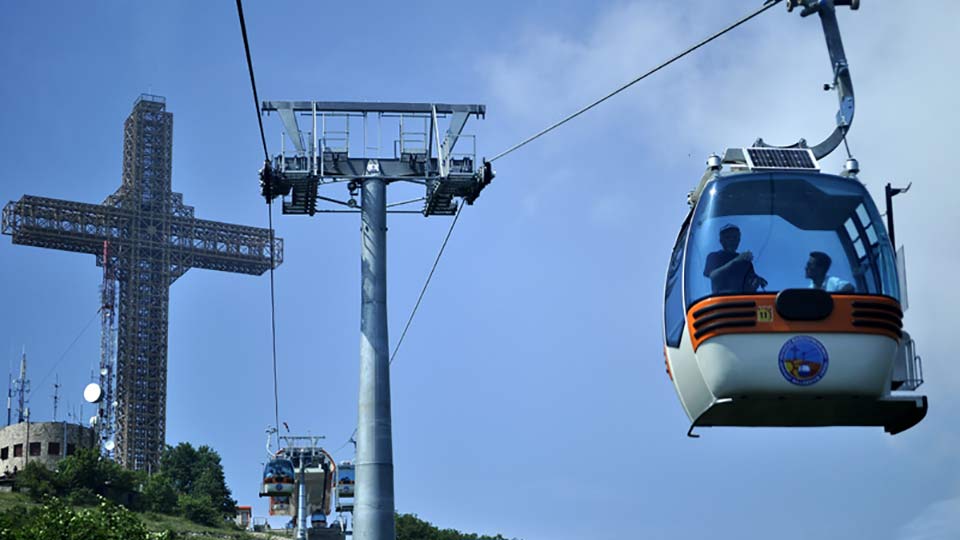
Macedonian ethno-village
Macedonian Village is a complex with 12 ethno houses from various regions of Macedonia (Berovo, Struga, Tetovo, Gostivar, Bitola, Prilep and so on), which offers accommodation for guests and tourists and includes other accompanying elements (rural yard, watermill, barn, fountain, but also a museum, amphitheatre, souvenir shop, restaurant, etc.).
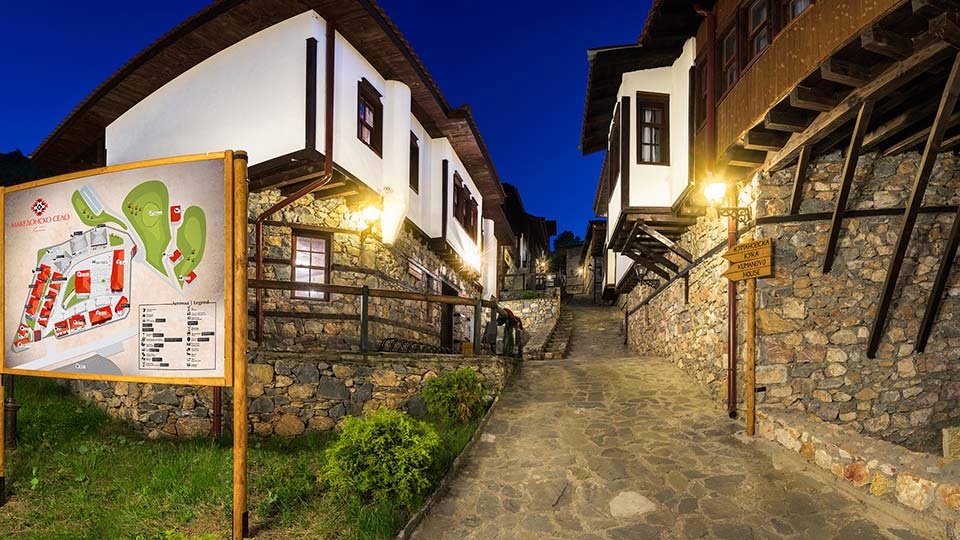
Other cultural and sports facilities include: National Sport Arena "Philip II Macedonian", Boris Trajkovski Sports Centre, Jane Sandanski Sports Centre, Aqua Park, Hippodrome etc. In Skopje, during the year, a number of manifestations are organized - cultural, music, dramatic, art, literary, sports, entertainment, scientific, and the like. The most important are: "Skopsko Leto (Skopje Summer)", "Skopje Jazz Festival", "May Opera Evenings", "White night", "Baskerfest", "Youth Open Theatre", "Pivoland", "Vinoskop" and many other.

